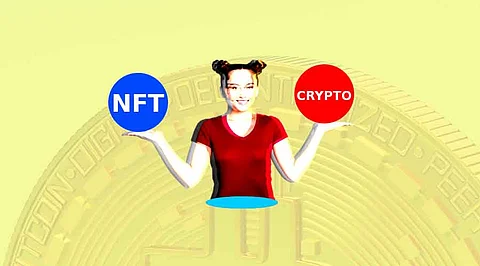
- Insights
- Cryptocurrencies
- Stocks
- White Papers
- Industry
- Geography
- Insights
- Cryptocurrencies
- Stocks
- White Papers
- Industry
- Geography


The two most common blockchain-based applications are cryptocurrencies and NFTs. Although there is a lot of overlap in how the two operate, there are also significant variances. Both cryptocurrencies and NFTs have a wide range of applications. Cryptocurrency is a digital form of money that uses encryption and blockchain technology to verify transactions independently of financial institutions. Unique digital assets that are maintained on a blockchain and cannot be copied or cloned are known as NFTs. Let's analyze the differences between NFTs and cryptocurrencies in more detail.
NFTs, or non-fungible tokens, are distinct digital assets without a physical form, encompassing various media like images, music, videos, collectibles, and more. Virtually any digital item, from virtual characters and real estate to original social media posts, can be transformed into and acquired as NFTs. These unique tokens are stored on distributed ledger technology, often using blockchain.
This digital ledger enables NFTs to be managed, traded, and bought online. Every transaction is securely recorded on the blockchain, publicly verifying ownership. NFTs typically possess variable values determined by creators and influenced by market demand, with blockchain ensuring the ledger's immutability, making it resistant to tampering.
Cryptocurrency, an encrypted form of digital currency, operates independently of governments or financial institutions. It is typically stored in a crypto wallet, enabling users to send and receive payments without relying on traditional intermediaries. These transactions are securely recorded on an immutable distributed ledger.
Many organizations issue their cryptocurrencies, often referred to as tokens, facilitating trade for specific products or services. To acquire these tokens, individuals exchange real currency. Some well-known cryptocurrencies include:
There are several differences between the two, including the following:
Transactions: Cryptocurrency transactions are how digital assets are transferred between users. When one user wishes to send cryptocurrency to another, they initiate a transaction. This transaction typically includes the recipient's wallet address, the amount to be transferred, and a digital signature to authenticate the sender's ownership.
Public Ledger: Cryptocurrency transactions are recorded on a public ledger, commonly referred to as the blockchain. The blockchain is a decentralized and immutable ledger that stores a chronological record of all transactions across the network. This ledger's transparency ensures that every transaction is publicly verifiable, enhancing trust and security within the network.
Mining and Validation: Most cryptocurrencies rely on consensus mechanisms like Proof of Work (PoW) or Proof of Stake (PoS) to validate and add transactions to the blockchain. In a PoW system, miners compete to solve complex mathematical puzzles, and the first to succeed gets the right to validate a block of transactions.
Creation: NFTs are created through a process known as minting, during which artists and creators tokenize their assets by registering them on a blockchain. This registration includes crucial details like ownership rights, metadata describing the support, and a unique identifier linked to the NFT. This process effectively transforms a digital or physical item into a digital certificate of ownership.
Ownership Verification: NFTs serve as cryptographic certificates of ownership, leveraging the security and transparency of blockchain technology. Each NFT is associated with a unique identifier that verifies its authenticity. This verification mechanism makes NFTs extremely resistant to counterfeiting or tampering, ensuring the integrity of the ownership record.
Smart Contracts: Many NFTs incorporate smart contracts, self-executing scripts on the blockchain that automatically execute predefined actions when specific conditions are met. In the context of NFTs, smart contracts can facilitate various functionalities, such as automatically distributing royalties to creators whenever their NFTs are resold in secondary markets. This innovation ensures that creators continue to benefit from the ongoing value of their work.
